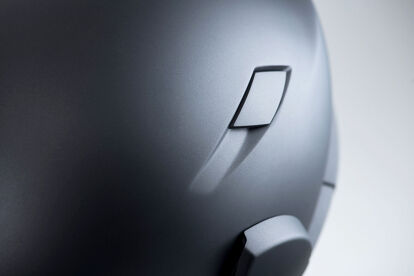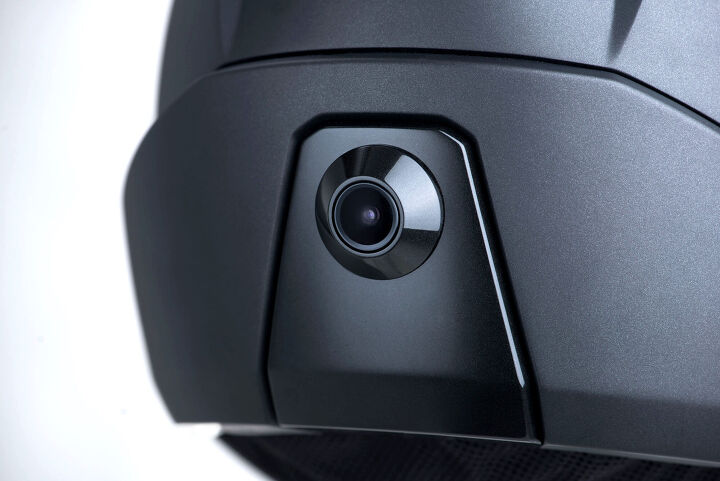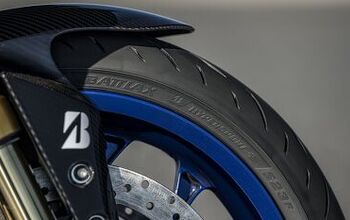CrossHelmet X1 – The Future of Motorcycle Helmets?
Tokyo-based company engineers high-tech brain bucket
These days technology is developing faster than ever, and just when you’ve saved up enough hard-earned cash and purchased the latest and greatest gadget, a better, faster, sleeker model hits the market and renders yours a dinosaur. Damn it! On September 13th, Tokyo-based company Borderless Inc. launched a Kickstarter campaign for its newest design – the CrossHelmet X1, a smart helmet that features an integrated heads-up display (HUD) with claimed 360-degree field of view, ambient sound control and Bluetooth connectivity to your smartphone. The crowd-funding campaign has since amounted over $277,000 – almost three times its goal – and continues to rise even as I write this.
If this sort of thing sounds somewhat familiar, that’s because it is. The motorcycle industry saw a very similar case with the Skully AR-1 helmet not long ago. If you’re not familiar with this fiasco that left a sour taste in the mouths of the moto-tech world, I’ll give you a quick rundown. The Skully AR-1 was a helmet with features similar to the CrossHelmet that was thought to potentially revolutionize the motorcycle helmet industry. Skully Inc. was able to raise $2.4 million in funding via Indiegogo and an additional $11 million from investors and managed to blow it all on exotic cars, lavish trips to hot destinations and strippers amongst other non-motorcycle helmet-related things… allegedly. All this culminated in the company filing for bankruptcy last year.
A new company under different ownership, Skully Technologies, (not to be confused with Skully Inc.) has acquired all of the former’s assets and plans on reviving the Skully helmet project. Although they have no formal responsibility to the investors whose money was squandered away, the company has just rolled out its “Make It Right” campaign where they will try to fulfill all of the former Indiegogo campaign’s promises made by the now defunct Skully Inc. on a first-come-first-served, level of investment basis.
In light of this multi-million-dollar disaster, investors can’t help but proceed with skepticism. However Arata Oono, founder and CEO of Borderless Inc., who almost certainly possesses exponentially more discipline than Skully’s CEO, is piquing investor’s interests to open their wallets into bringing the CrossHelmet X1 to production.
Unlike other HUD products currently available such as NUVIZ, the CrossHelmet X1 integrates all the technology within the helmet. Its most notable features include a rear camera with a lens that offers a 170-degree view behind the rider that is paired with a wide-view front visor that eliminates blind spots and provides about 30 degrees more peripheral vision over normal helmets. Combined, the X1 offers a theoretical 360-degree field of view.
Everything going on behind you in addition to other travel information such as speed, compass direction, weather, time and navigation is displayed on a transparent and foldable bifocal lens. Paired with your smartphone via Bluetooth you can also listen to music and send / receive phone calls with quality sound.
The CrossHelmet comes with a smartphone app available on iOS and Android that provides access to the helmet’s many features such as Group Talk where you can seamlessly connect to and speak with multiple riders in your group. This extends to include members without a CrossHelmet as long as they have some sort of Bluetooth communication device.
What is uniquely different about the CrossHelmet is its patented-noise control system. They call it CrossSound Control and it’s designed to reduce or enhance environmental sounds, depending on the rider’s needs via the app. It uses a special algorithm system they claim will filter out road, engine, and wind noise, while allowing noises such as screeching brakes or emergency sirens for rider safety. This technology is new to the motorcycle industry with the only other manufacturer currently playing with the idea being SENA with their Momentum INC™ Pro (Intelligent Noise-Control) helmet. More on the new SENA helmets here. It will certainly be interesting to see how this technology develops.
The CrossHelmet satisfies DOT, ECE and JIS safety standards and uses a solid-state lithium-ceramic battery that the designers ensure won’t spontaneously blow up on you. As far as pricing goes, all this technology will cost you a pretty penny to the tune of $1,799. The NUVIZ system has comparable features and is already available and for a fraction of the cost, priced at $699. On top of that, you can easily mount it to most full-face helmets. Additionally, the aforementioned SENA Momentum INC™ Pro will be available in early 2018, also priced at $699.
Other than the CrossHelmet’s lofty price, perhaps the other impediment to robust sales is the futuristic styling and features that will likely polarize some riders, especially older ones who enjoy the isolation, sounds and seat-of-the-pants sensations that come from riding. Our from-the-hip assessment is that the sharp angles and apparently large gaps might generate a good deal of wind noise at highway (or track) speeds. We at Motorcycle.com would love to someday test the CrossHelmet X1 to see how well it functions.
If all goes according to plan and investment continues, the next step is moving to production. The expected delivery date for the CrossHelmet X1 is currently Autumn / Winter of 2018. If you’re interested about learning more or backing the project visit CrossHelmet.com.
More by Brent Jaswinski






















































Comments
Join the conversation
How well does the rear view camera work riding TWO up? Hummm.
(Edit)
So much technology...so little attention paid to what's important...road conditions and other cagers.
As an aerospace life support specialist (and life-long motorcyclist/bicyclist), cranial protection technology has always been a primary focus for me, whether in the air, in space, or on the road. Although I presently use an excellent Australian VOZZ RS 1.0 motorcycle helmet (a radical new 'clamshell' fitting system that encloses the head like a clamshell), I am always on the lookout for interesting new technological methodologies in head protection. The CrossHelmet thus caught my eye immediately. These are my impressions: 1) I was greatly surprised to find absolutely nothing regarding what head-shape this helmet favors (as many know, there are three basic types: the 'round' head, the 'intermediate oval' and the 'long oval'; thus, proper helmet sizing/fitting demands not only a circumferential measurement, but information on what head shape the user has!); this indicates that the CrossHelmet needs further development in this critical area. 2) the vision capabilities of the CrossHelmet are indeed impressive, both regarding the allowable peripheral field of vision and the 'rear-view' monitor aspect, since peripheral vision reduction in both vertical and bilateral peripheral fields is a main complaint of many full-helmet wearers. 3) I remain ambivalent about the communication features of the helmet, since verbal and auditory interactions CAN (in addition to proving useful for navigation, etc.) constitute a potentially significant driving hindrance (and any sort of distraction while driving is a serious liability, whether electronic/no-hands or not). I would have to test the helmet's communication features to make a determination whether that feature is a step forward...or not. 4) The aerodynamic technology incorporated in the CrossHelmet (as well as I am able to determine it) is commendable, since aerodynamic forces (wind effects) are substantial for motorcyclists and should always be prioritised. 5) User comfort is a further chief consideration, but this refers directly back to my earlier comments on head-shape (which remains unclear, concerning the CrossHelmet at this time). 6) the bi-lateral lighting feature is potentially excellent, although exactly to what extent is also unclear, given motorist carelessless and ineptitude in road awareness. Finally, 7) I was surprised that a high-visibility color option is not part of the basic, standard feature line-up, since 'looking cool' is a trivial matter next to 'see and be seen' survival concerns. I would strongly suggest a standard 'Hi-Viz' Safety Green color option (with no distracting graphics) in addition to perhaps a basic white and a black (despite the fact that black is not nor has ever enhanced road visibility; too many people think black is a requisite part of 'looking cool', sadly enough!).